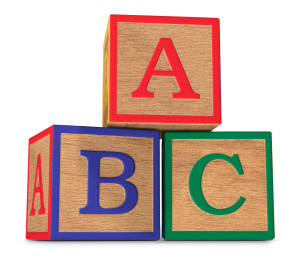Running form: Re-learning your ABC’s
If you want to improve your running form, then you have to start at the beginning. Time to re-learn your "A, B, C's"

 A common misconception is that the form or body posture associated with running barefoot is a newer idea – it isn’t. Good barefoot running form has nothing to do with barefoot running at all – it’s just good running form.
A common misconception is that the form or body posture associated with running barefoot is a newer idea – it isn’t. Good barefoot running form has nothing to do with barefoot running at all – it’s just good running form.
Good running form is taught and practiced on most college running tracks. The problem is that most of us have never managed to make it to the college running team, so this is all new to us. Most runners have spent months if not years running with appalling form. Fixing your running form is hard.
There are many training programs that teach good running form: Chi, Pose, “Good Form”, VIVOBarefoot to name a few. A lot of barefoot runners have found that these courses — although useful — can be too structured, because some coaching programs or trainers fail to understand one important point — we are all unique.
Structurally, I am nothing like you, and in turn, you are not structurally built the same way as your neighbour. A prescriptive program, although attempting to be helpful, may sometimes cause more problems than it fixes. Despite this, there are some commonalities in the ‘Good-running-form’ programs, that if followed will lead you on to the path of running well – regardless of what is on your feet.
These techniques can be practiced with or without shoes. However, the more you have on your feet, the harder it is to practice the techniques. Heel-toe differences, cushioning and support in your shoes makes it difficult for your body to react instinctively as you land. This affects the development of good running form.
I am stealing the following terms from Jason Robillard and his work with the Barefoot Running University and Merrell.
I prefer his technique for a number of reasons:
- It’s easy to remember and apply;
- It will probably fix the major issues with your form;
- The information is accurate and widely accepted and;
- This technique has been tested in the field
His technique is called the “A, B, C’s”.
A stands for Align posture. A simple way of achieving this is to stand upright, feet planted underneath your hips. Slowly raise your arms above your head – like you are stretching in the morning. Without altering your core posture, gently bring your arms to the ground. Your core should be engaged and your posture balanced.
I also include the additional phrase, “pelvis under, chest out.” This cue seems to cure the problem of a curved back/unengaged pelvis — a natural consequence when walking and running in heeled shoes for years.
B stands for Balanced foot strike. This is usually taught by getting the participants to walk on the spot with an aligned posture. You will find as you walk on the spot that your feet will automatically land underneath you in a mid-/forefoot landing. You will also pick up your feet instead of pushing off with your toes. This technique is similar to the 100-ups that Christopher McDougall promotes.
C stands for Cadence. (In my opinion, this is the most important part of the equation). Cadence is defined as the number of steps taken in a period of time. When you are running with good form you are aiming for a minimum of 180 steps per minute; 90 right, 90 left. A lot of experienced runners will have a higher cadence than this — sometimes more than 200 steps per minute. Most runners will run with a cadence of about 160 steps per minute.
If you achieve a cadence of 180 steps a minute you will find the following:
- Your stride length will shorten;
- You will automatically land underneath you;
- Your foot strike will be mid- or forefoot and;
- Your posture will be straighter.
Anything less than 180 steps per minute and you will over-stride, heel-strike and run with your head leading, not your chest.
Achieving the right cadence is hard to do when you are starting out. Some people run with an iPod playlist of 180 beats per minute, some even download a metronome program to their mp3 player. I discovered that I can quickly check my cadence by chanting a ‘double-time military march’ in my head.
The three simple rules above will not fix all of your form, but it will get you about 80 per cent there.
The additional 20 per cent of your form will come from your own personal (structural) tweaks. They will only be found through trial and error. They will be the subtleties that come from experience and from understanding the messages your feet and legs are telling you. If it feels wrong then it is wrong.
Relearning your A, B, C’s may be your most important step on the path to not good barefoot running, but just good running.


